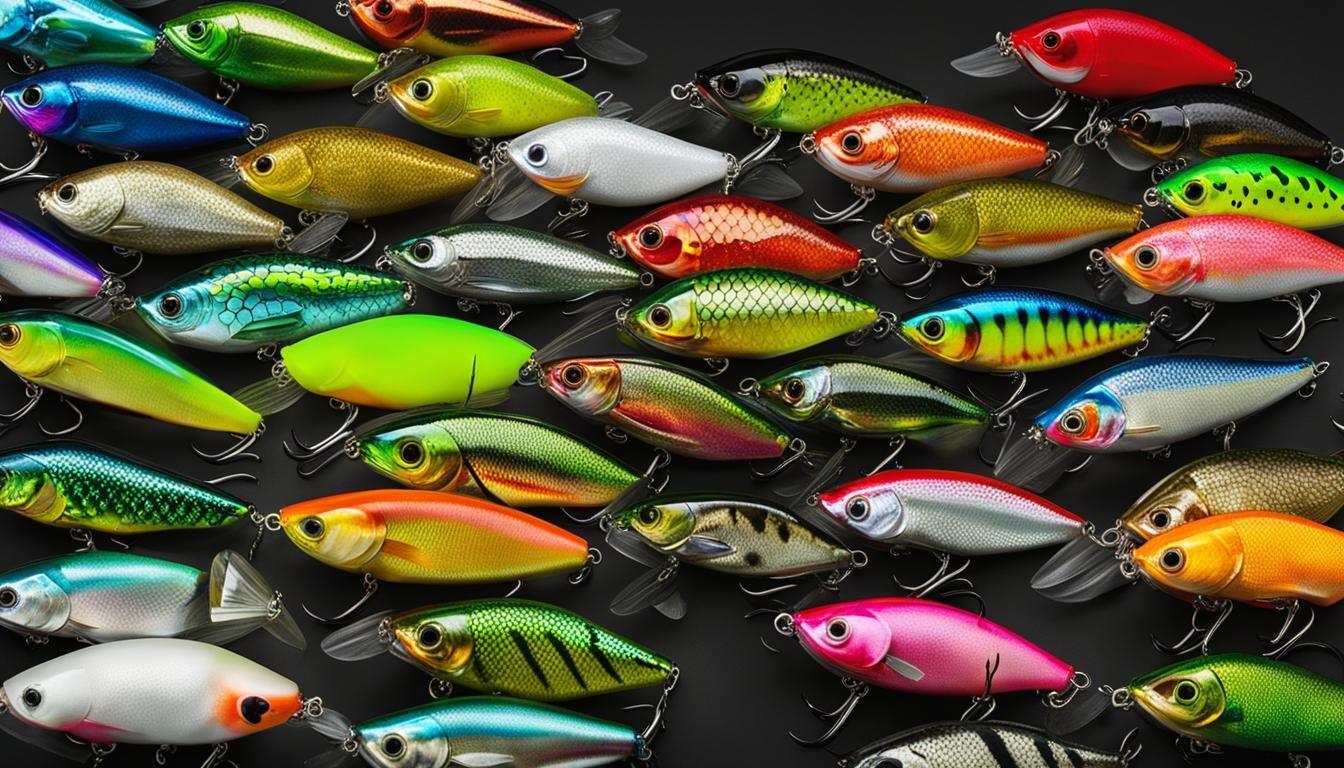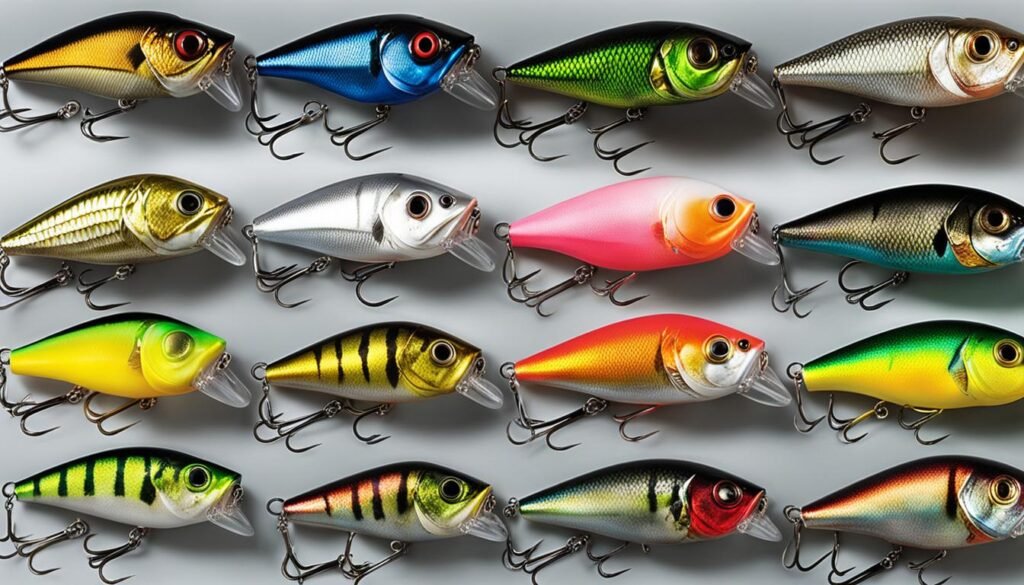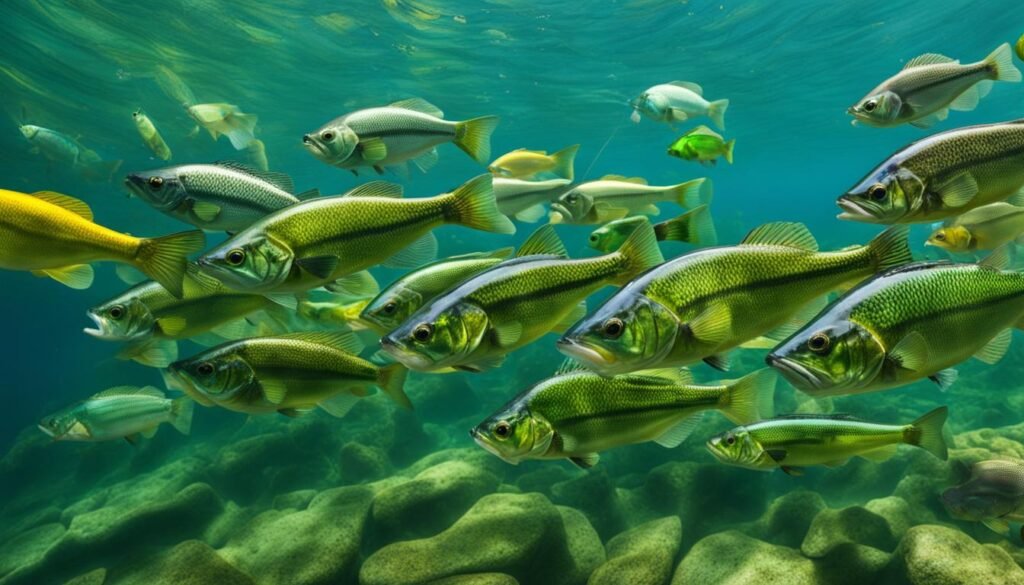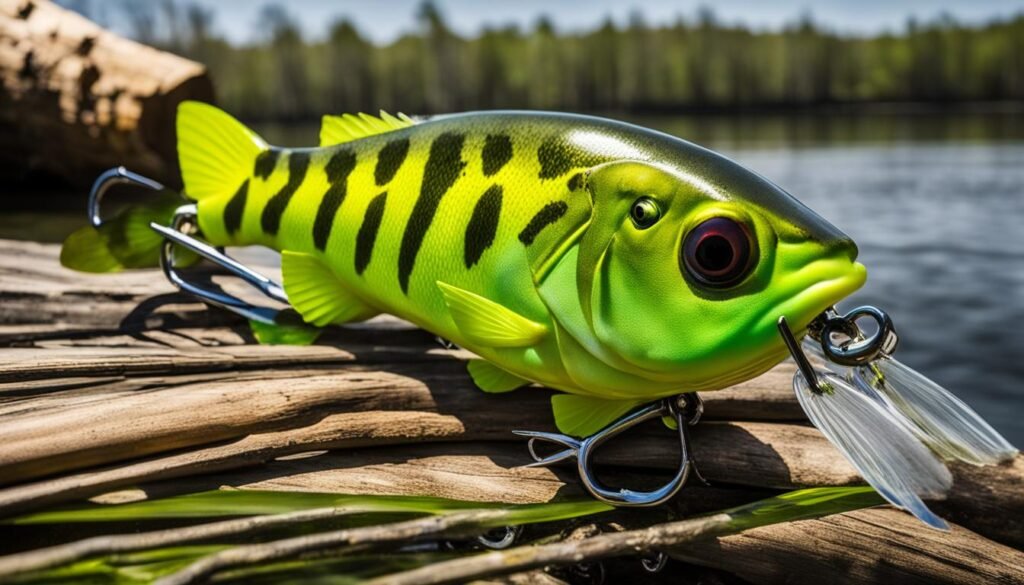Choosing the right crankbait colors is not just a matter of personal preference, but a strategic decision based on understanding how colors influence crankbait effectiveness. Different colors can trigger different responses from bass, depending on the conditions and their feeding patterns.

- Understanding the Role of Color in Bass Fishing
- Factors Influencing the Effectiveness of Crankbait Colors
- Choosing the Right Crankbait Colors for Clear vs. Murky Waters
- Debunking Common Myths About Crankbait Colors
- How Bass Perception Influences Your Crankbait Color Choice
- Seasonal Variations: Adapting Crankbait Colors for Success
- Crankbait Colors Impact: Maximizing Your Catch
- Top Crankbait Color Selection Tips for Prominent Forage Matching
- FAQ
Understanding the Role of Color in Bass Fishing
The Importance of “Match the Hatch”
When it comes to selecting crankbait colors, one important concept to understand is “Match the Hatch.” This involves choosing colors that closely mimic the baitfish that bass are feeding on. By imitating the natural colors of the prey species, you can increase your chances of attracting strikes from bass. Matching the hatch is a strategy that many experienced anglers employ to enhance their fishing success.
Water Clarity and Color Selection
Another crucial factor to consider when selecting crankbait colors is water clarity. In clear water conditions, more natural and subtle colors tend to be effective in fooling bass. These colors blend in with the surrounding environment and appear more realistic. On the other hand, in murkier water with reduced visibility, it is important to use vibrant and high-contrast colors that can stand out and catch the attention of bass.
Light Conditions: Bright Days vs. Overcast
Light conditions can also influence the visibility of crankbait colors underwater. On bright, sunny days, the water tends to be clearer, allowing bass to see colors more accurately. In such conditions, choosing colors that closely match the natural prey species becomes even more important. However, during overcast weather, light penetration into the water is reduced, and colors may appear less vibrant. In these situations, using brighter colors can help your crankbait stand out and attract attention.
Wind Conditions and Color Selection
Wind conditions can also impact the choice of crankbait colors. In calm conditions, natural colors that closely mimic the surroundings work well because they blend in and appear less threatening to bass. However, in higher wind speeds, when the water is choppy and disturbance is greater, using more aggressive colors can be effective. These colors create a strong visual contrast to the chaotic environment, increasing their visibility to bass.
Factors Influencing the Effectiveness of Crankbait Colors

When it comes to choosing crankbait colors, several factors come into play that can influence their effectiveness in attracting bass and triggering strikes. Understanding these factors will help you make informed color choices and maximize your success on the water.
Bass Perception: Bass have different sensory inputs, including vision, lateral line detection, and sense of smell. While vision is important, it’s not the sole factor in determining a bass’s response to color. Considering how bass perceive colors and how they interact with their environment is crucial when selecting crankbait colors
Local Prey: Understanding the prevalent prey species in your fishing area is key to choosing the right crankbait colors. Bass are conditioned to feed on specific prey, and selecting colors that closely mimic the colors of local baitfish can increase your chances of attracting strikes.
Environmental Colors: The colors present in the surrounding environment can also influence the effectiveness of crankbait colors. Factors such as water clarity, light conditions, and even wind conditions can impact color visibility and how bass respond to different hues. Adapting your color choices to match the environmental conditions will help you optimize your fishing experience.
DISCLAIMER: The links I mention may be affiliate links. If you purchase through one of these links I may receive a commission, at no cost to you. As an Amazon Associate I earn from qualifying purchases.
Choosing the Right Crankbait Colors for Clear vs. Murky Waters

The water clarity can significantly impact the effectiveness of crankbait colors. When fishing in clear water, it’s important to choose more natural and subtle colors. These colors closely mimic the appearance of the baitfish in clear water, making them more appealing to bass. The goal is to create a realistic presentation that blends in with the natural surroundings.
On the other hand, when fishing in murky water, vibrant and high-contrast colors can be more noticeable to bass. The cloudy and muddy conditions reduce visibility, and the bass rely more on their lateral lines and vibrations to detect prey. Therefore, using bright colors that create a strong silhouette and can be easily seen in the low visibility can increase your chances of attracting strikes.
It’s crucial to adapt your color selection to different water conditions. Assessing the water clarity before you start fishing can guide your choice of crankbait colors. By selecting the right colors, you maximize the chances of attracting bass and triggering strikes, ultimately leading to a more successful fishing experience.
Debunking Common Myths About Crankbait Colors
When it comes to crankbait colors, there are several myths that need to be debunked. Let’s address some of the most common misconceptions and shed light on the importance of color selection in bass fishing.
Is Color Really That Important?
Many anglers question whether crankbait color truly matters when it comes to attracting bass. The truth is, color plays a significant role in triggering bass behavior. Different colors can elicit different responses from bass, so choosing the right hues can greatly enhance your chances of success on the water.
The Misconception of Bright Colors
One prevalent myth is that only bright colors are effective in all fishing situations. While it’s true that bright colors can be eye-catching and work well in certain conditions, they are not the only option. Bass are intelligent predators, and their preferences can vary depending on factors such as water clarity, light conditions, and local prey species. It’s essential to consider these variables and select colors that closely mimic the natural forage the bass are feeding on.
Dark Lures: Not Just for Night Fishing
Another myth that needs debunking is that dark-colored lures are only suitable for night fishing. Dark-colored crankbaits can be equally effective during the day, depending on the water conditions and the prey species you’re imitating. In murky water or when imitating specific prey with darker coloration, such as crawfish, dark-colored lures can be highly successful in attracting strikes. Don’t be afraid to experiment with different colors to find what works best in your fishing area.
How Bass Perception Influences Your Crankbait Color Choice

Bass perception is a crucial factor in determining the effectiveness of crankbait colors. While vision plays a significant role, bass also rely on other sensory inputs, such as lateral line detection and sense of smell, to detect and locate prey. Understanding how bass perceive colors and how they interact with their environment and local prey can help you make informed decisions when choosing the right crankbait colors to trigger strikes.
Vision vs. Other Sensory Inputs
Vision is an important sense for bass when it comes to detecting and reacting to their surroundings. Bass have excellent vision underwater, which allows them to distinguish different colors. However, it’s important to note that their sensory receptors extend beyond vision.
Bass have a lateral line system that detects subtle vibrations and water movements, helping them locate prey even in low light or murky conditions. This sensory input allows bass to sense the presence and movement of crankbaits, even if they cannot see them clearly.
Sense of smell also plays a role in bass perception. Bass possess olfactory receptors that enable them to detect chemical cues in the water, helping them identify potential prey. This sense of smell can be particularly important when fishing in situations where visibility is limited.
Local Prey and Environmental Colors
Understanding the local prey species and the colors they exhibit is key to choosing effective crankbait colors. Bass are opportunistic feeders and are adapted to target the prevalent prey species in their habitat. By selecting crankbait colors that closely resemble the colors of the local prey, you can increase the chances of triggering a strike.
Environmental factors, such as water clarity and light conditions, also influence color perception. Clear water and bright sunlight can enhance the visibility of crankbaits and make more natural and subtle colors effective. In murkier water or low light conditions, opting for high-contrast and vibrant colors can help your crankbaits stand out and attract attention.
To optimize your color choice, consider the overall appearance your crankbait will have underwater. This includes the interaction between the crankbait’s color, reflective properties, and the surrounding light conditions. Experimenting with different colors and analyzing the response of bass in your local fishing area can provide valuable insights into the most effective color choices.
Seasonal Variations: Adapting Crankbait Colors for Success

Crankbait color selection can vary with the seasons, and understanding these seasonal variations is essential for maximizing your success on the water.
Spring Spawn: Color Strategies
During the spring spawn, bass are focused on reproduction, and their behavior can be influenced by their nesting instincts. To trigger strikes, it’s crucial to choose crankbait colors that mimic the appearance of their preferred spawning prey. Natural and subtle colors such as greens, browns, and shad patterns are effective in imitating the forage species present in the spawning areas. These colors can provoke territorial responses from bass, enticing them to strike out of aggression or to defend their nests.
Additionally, lighter-colored crankbaits can stand out in the clearer waters of the spring, making them more visible to bass. This visibility can be especially important when targeting bedding bass, as they tend to guard their nests and may strike out of aggression against intruders.
Fall Feeding: Selecting the Optimal Palette
As the seasons transition to fall and bass enter a period of aggressive feeding, their preferred forage changes, requiring a different color approach to attract bites.
During the fall, baitfish and crawfish become prominent forage for bass as they prepare for the winter months. To effectively mimic the seasonal prey, crankbait colors that imitate these forage species can be highly productive. Vibrant and high-contrast colors such as oranges, reds, and black-brown combinations can stand out in the water, catching the attention of feeding bass. These colors allow you to present a bait that closely resembles the baitfish and crawfish that bass are actively targeting in the fall.
Remember to also consider the water clarity during this time of year. In murkier water conditions, it may be beneficial to use brighter and more aggressive colors to increase the visibility and provoke a reaction from bass.

By adapting your crankbait colors to the seasonal variations in bass behavior and forage preferences, you can significantly improve your catch rate. Understanding the color strategies for the spring spawn and fall feeding seasons will give you a competitive edge and increase your chances of success on the water.
Crankbait Colors Impact: Maximizing Your Catch
When it comes to crankbait fishing, color selection plays a crucial role in maximizing your catch. Understanding the psychology of color in bass fishing and knowing how to balance proven patterns with experimental hues can greatly enhance your success on the water.
The Psychology of Color in Bass Fishing
The psychology of color in bass fishing revolves around the idea that different colors can trigger various responses from bass. By understanding the effect of colors on bass behavior, you can strategically choose crankbait hues that are more likely to attract strikes. For example, bright and vibrant colors like chartreuse or firetiger can elicit aggressive responses from bass, while more natural and subtle colors like shad or crawdad imitations can mimic their natural prey and trigger feeding behaviors.
To maximize your catch, consider the environmental factors and the mood of the bass. In murky water or low-light conditions, using high-contrast colors can make your crankbait more visible. Conversely, in clear water or bright conditions, opting for more natural colors can help your bait blend in with the surroundings, increasing its effectiveness.
Sticking to Proven Patterns vs. Experimental Hues
When it comes to crankbait color selection, there are two approaches you can take: sticking to proven patterns or trying out experimental hues. Proven patterns refer to colors that have consistently yielded successful catches, such as classic combinations like black and blue or green pumpkin. These colors have proven their effectiveness over time and are a reliable option to consider.
On the other hand, experimenting with new and unique color combinations can help you gain an edge in certain situations. Sometimes, bass may become conditioned to the same old colors, and trying something different can trigger their curiosity and entice them to strike. You might consider experimenting with subtle variations of proven patterns or even completely new color schemes to see if they yield better results in your fishing area.
Top Crankbait Color Selection Tips for Prominent Forage Matching
Matching your crankbait colors to the prominent forage in your fishing area is crucial for increasing your chances of attracting strikes. By understanding the preferred colors of the forage species that bass are feeding on and imitating them with your crankbaits, you can optimize your fishing success.
Here are some top tips for selecting the right crankbait colors to closely mimic the forage:
- Observe the natural colors: Take a close look at the local forage species, such as shad, minnows, or crawfish, and note their predominant colors. Look for patterns like silver scales, green or brown hues, or even red accents in the prey. These observations will guide your color selection.
- Consider the water clarity: The clarity of the water also plays a role in color visibility. In clear water, choose natural and subtle colors that closely resemble the forage. In murkier or stained water, opt for more vibrant and high-contrast colors to help your crankbait stand out and catch the attention of bass.
- Experiment with different shades: Sometimes, the forage may have variations in coloration due to factors like water temperature or vegetation. Don’t limit yourself to a single color. Experiment with different shades of the same color to match the diversity in the forage population.
- Utilize color patterns: Mimicking the color patterns or markings of the forage can be highly effective. For example, if the predominant forage species have vertical stripes, choose a crankbait with similar striping to trigger strikes from bass.
- Take weather conditions into account: Remember that weather conditions can impact the appearance of the forage. On bright sunny days, crankbaits with metallic finishes or brighter colors may mimic the reflective qualities of the forage. On cloudy or overcast days, opt for more subdued colors to imitate the subdued lighting conditions.
Looking For More Bass Fishing Lures and Baits?
Check out our other articles to find and learn more about the best lures and baits for bass
FAQ
What is the impact of crankbait colors on bass fishing?
Crankbait colors can significantly impact your success on the water by attracting strikes from bass.
How does understanding the role of color in bass fishing help with crankbait color selection?
Understanding color’s impact on bass behavior allows you to choose the right crankbait hues that mimic their prey and optimize your catch rate.
How does water clarity affect the choice of crankbait colors?
In clear water, natural and subtle colors work best, while in murky water, vibrant and high-contrast colors are more noticeable to bass.
Are bright colors always the most effective for all fishing situations?
No, dark lures can be equally successful, especially when imitating specific prey species or in certain water conditions.
How does bass perception influence crankbait color choice?
Bass perceive colors through vision, lateral line detection, and sense of smell, so understanding their perception helps select the right colors to trigger strikes.
Does crankbait color selection vary with the seasons?
Yes, different seasons require different color strategies, such as matching the hatch during spawning and selecting the optimal palette during fall feeding.
How can crankbait color maximize your catch?
Understanding the psychology of color in bass fishing and balancing proven patterns with experimental hues can increase your chances of success.
What are some top crankbait color selection tips for matching the prominent forage?
Select colors that closely mimic the forage species bass are feeding on to increase your chances of attracting strikes.




